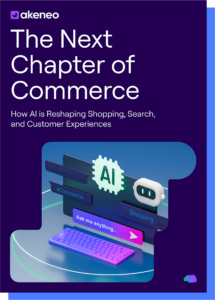Explore how artificial intelligence is revolutionizing the way users find and interact with products online. From enhancing traditional search engines with machine learning and natural language processing to enabling visual and conversational search, this blog dives into the real-world impact of AI on product discovery. Learn how leading retailers are using AI to anticipate user intent, surface relevant results, and deliver seamless search experiences that keep customers engaged and coming back.

Table of Contents
Keywords
Product search and discovery were two very different experiences in the past. You see, online search was simple. After typing something simple like “black shoes” into Google, you crossed your fingers and hoped the algorithm would find information that didn’t look like it belonged in a 2002 fashion catalog.
Discovery, on the other hand, was mostly accidental—you’d stumble across something interesting while navigating a labyrinth of categories, filters, and miscategorized products and click ‘add to cart’. But in today’s digital world, where attention spans are short and expectations are sky-high, that kind of experience just doesn’t cut it anymore.
This is where Artificial Intelligence (AI) comes in, the not-so-silent partner behind eerily accurate recommendations, voice assistants that finish your sentences, and platforms that seem to know what you want before you do. From semantic search to generative answers, AI is fundamentally changing how we find, explore, and even think about product information.
As you might have guessed, search refers to the act of looking for a product, while discovery encompasses the results (and sometimes the unexpected opportunities) that come from that search. From the early days of digital search and eCommerce until now, most systems have relied on traditional, keyword-based search engines. These engines operate on a simple principle: they match the exact words in a user’s query with terms found in a brand’s product catalog or content database. If a customer entered the precise name of a product or category, they were usually presented with relevant results.
This approach worked reasonably well when product catalogs were small and customer expectations were even smaller. But as online inventories expanded and customer expectations evolved, the limitations of keyword search have become increasingly apparent. If a customer uses a synonym, introduces a typo, or describes the product in a way that didn’t match the catalog’s wording (such as saying “sofa” instead of “couch” or misspelling “headphones”), the search engine often fails to return useful results.
In short, traditional search and discovery helps users hunt, but it doesn’t help them explore.
As customer expectations grow more sophisticated, so does the technology designed to meet them. AI-powered search engines have emerged as a powerful evolution of traditional search, one that is smarter and far better at figuring out what customers actually mean. Instead of treating every query as a literal checklist, AI search is an intelligent approach that uses technologies like machine learning and natural language processing (NLP) to understand user intent, context, and behavior.
Rather than relying solely on rules and product tags, AI search can learn from user behavior, adapt to evolving trends, and return results that align with the user’s intent, even when their query doesn’t match exact keywords. It draws insights from what people click on, what they skip, and how they refine their searches.
For example, let’s say a customer is searching for “best trail running shoes for wet conditions”. A traditional search engine would return any results that are tagged “running shoes”, “trail running”, or “shoes for wet conditions”, leaving our customer to weave through trail running backpacks, mesh running shoes, or even rubber rain boots.
But if we run the same search query with an AI-powered search engine, it will analyze thousands of customer reviews to find the trail running shoe with the most mentions of being waterproof, check the most frequently purchased sneaker in areas where muddy trail running is popular, and cross-reference return rates after a particularly rainy season to populate the most relevant products possible. Instead of simply matching specific keywords, AI offers the ability to better understand the intent behind the search, surfacing the most relevant results rather than generic products that contain a single word from the original search.
To better understand how AI is reshaping search and discovery in retail, it helps to look at real-world applications. From interpreting vague queries to delivering hyper-personalized recommendations, AI is driving improved shopping experiences. Below are several examples that highlight how leading retailers are using artificial intelligence to transform the way customers find and engage with products.
In early 2024, Amazon launched Rufus. Trained on Amazon’s vast product catalog and supplemented with information from across the web, Rufus acts as an intelligent shopping assistant that provides real-time answers, product comparisons, and tailored recommendations. Instead of typing a product name, users can ask Rufus things like: “What should I consider when buying running shoes for flat feet?” or “What are some fun birthday gifts for a 5-year-old?”. Rufus then responds with context-aware, human-like answers and curates relevant product suggestions based on millions of product listings, reviews, and customer behavior. This turns product search into a discovery journey, particularly helpful for undecided or first-time buyers!
AI can analyze user behavior across sessions to anticipate what individual customers want, sometimes before they even know it themselves. It can factor in previous purchases, time spent on certain product pages, items viewed together, and more to suggest relevant items. Take Sephora, for example. Their AI-powered “Virtual Artist” app lets users virtually try on makeup, but beyond that, their recommendation engine uses a customer’s skin tone, past purchases, and browsing habits to suggest personalized products, such as foundation in the right shade or moisturizers perfectly suited to their complexion and concerns, even if they hadn’t explicitly searched for it.
AI-powered visual search allows users to upload a photo, like a jacket they saw on Instagram, and find similar styles available for purchase. This eliminates the guesswork of trying to describe a visual item with keywords, transforming casual inspiration into direct shopping opportunities. An example would be IKEA’s app that features visual search so a customer can snap a picture of a table they like and get matching or complementary furniture suggestions.
Voice search, on the other hand, enables hands-free browsing. Instead of typing, customers can simply speak their queries, making shopping more intuitive and accessible. Walmart incorporates voice shopping via smart speakers, letting users add items to their cart by simply saying what they need. This technology understands context and intent, providing a seamless, conversational user experience, whether you’re multitasking at home or on the go!
While AI significantly enhances search and discovery, it’s not without its challenges. Here are some key ones:
AI and Product Information Management (PIM) work together to transform the search experience by ensuring that product data is not only accurate but also optimized for how users search, speak, and browse. A PIM system provides the structured foundation needed for any search engine—centralizing attributes, categories, and rich product descriptions. Artificial intelligence, especially technologies like natural language processing and machine learning, enhances this foundation by analyzing how people express their needs, interpreting search queries, and enriching product data to align with users’ intentions.
By feeding enriched and structured product information into search systems, AI in search can better understand context, anticipate intent, and support the future of search where discovery is intuitive and personalized. The result is a more dynamic and satisfying user experience, one where customers can quickly find information and uncover the right products, even when their queries are vague, conversational, or unstructured.
AI is redefining search and discovery by moving beyond rigid keyword matching to deliver experiences that are more aligned with user intent. Whether through natural language understanding, visual search, or behavior-driven recommendations, AI is turning search into a powerful engine for exploration and engagement.
As this technology continues to evolve, the focus will shift even more toward delivering relevant, context-aware results that help users find what they need quickly and meaningfully. To support this shift, businesses will need to ensure that the underlying product information is clear, consistent, and structured enough for AI to do its job effectively. The future of search is already here and it’s driven by intelligence, not just input.
Discover how AI is transforming shopping, search, and product experiences, and why clean, structured data is the key to staying competitive in the next era of commerce.
